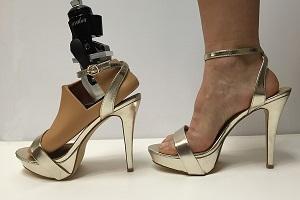And now for something completely different. Here's a scenario that you may never have thought of but engineers have had to grapple with. A woman loses a limb and gets a prosthetic limb to replace it. She gets invited to a wedding that requires formal wear. How does the woman wear high-heels to this event? This is the big question that Johns Hopkins University students want to answer. A team of engineers recruited some physician students and prosthetics experts and got to work. What they produced was a solution named Prominence. The first prosthetic foot that is custom designed to fit into high-heels of up to four inches high.
 Credit: Johns Hopkins University
Credit: Johns Hopkins University
"High heels have become an integral part of the female lifestyle in modern society, permeating through all aspects of life -- professional and social," said the students from the Whiting School of Engineering. "For female veterans of the U.S. armed services with lower limb amputations, that seemingly innocuous, but so pervasive, and decidedly feminine part of their lives is gone."
The researchers say that 2,100 American women have lost their leg or a foot in military service and wanted to give the women a chance to reexperience the feelings of going to a formal event and wearing the same clothes as able-bodied people did. The prosthetic feet that are currently available on the market are actually built for men's shoes without a woman's desire to wear a high-heel ever considered.
Here were some of the challenges that the engineering students faced when having to design a prosthetic foot that would also be able to contort itself so that it could fit into a heel without causing the wearer displeasure:
- A foot that is adjustable without a tool to help it adjust for different heel heights
- Ensure that it does not slip once adjusted
- Weighs less than three pounds so that it is not too heavy
"An adjustable ankle is useful in contexts even beyond high heels. Ballet, flats, sneakers, boots, and high heels especially, all vary in height, so an adjustable ankle opens up opportunities to wear a variety of shoes," said Alexandra Capellini, one of the students who had lost her leg to bone cancer who was participating in the study.
- A 28-layer carbon fiber foot plate was tested successfully
- There is still work to do, but they are closer to a working prototype
Nathan Scott, a senior lecturer in the Whiting's School's Department of Mechanical Engineering who is the advisor of the ongoing project, said: "I think the final prototype produced showed the way forward. As usual, we just need to go around the design and prototyping loop one more time."
